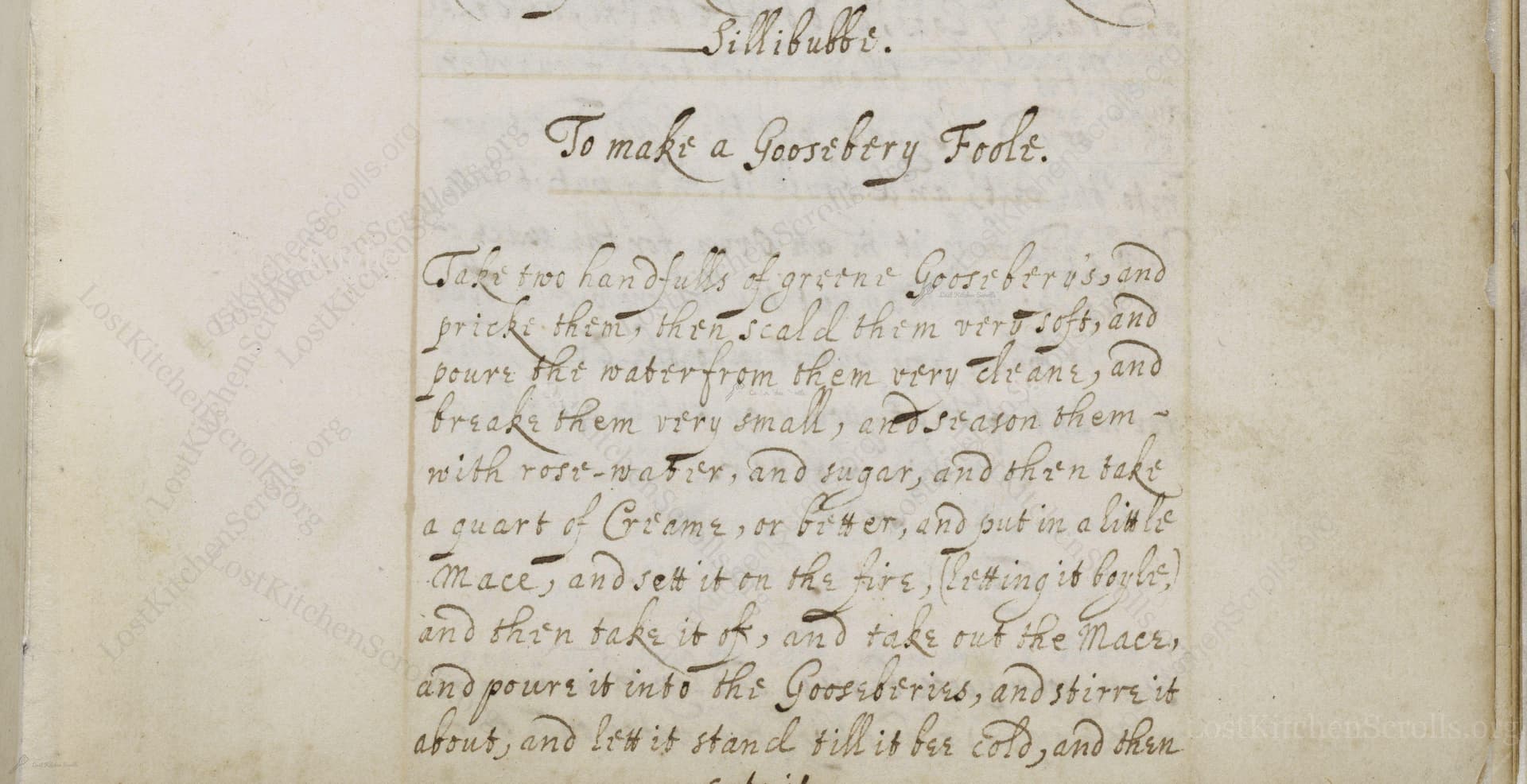To Make A Goosebery Foole
From the treasured pages of Receipt book of Sarah Longe
Written by Sarah Longe

To Make A Goosebery Foole
"Take two handfulls of greene Goosebery's, and prick them, then scald them very soft, and poure out the water from them very cleane, and breake them very small, and season them with rose-water, and sugar, and then take a quart of Creame, or better, and put in a little Mace, and sett it on the fire, (letting it boyle,) and then take it of, and take out the Mace, and poure it into the Gooseberries, and stirre it about, and lett it stand till it bee Cold, and then eate it."
Note on the Original Text
Recipes in the early 1600s were written as loose instructions rather than step-by-step directions, assuming the reader had experience in the kitchen. Measurements were imprecise ('two handfuls', 'a quart or better'), and cooking times omitted or implied by the cook’s intuition. Spellings were not fixed—'boyle' for 'boil', 'bee' for 'be', and so forth—reflecting contemporary conventions that varied widely by writer. Dishes like this were familiar enough that a brief method sufficed, and ingredients like gooseberries, cream, and rose water were seasonal staples.

Title
Receipt book of Sarah Longe (1610)
You can also click the book image above to peruse the original tome
Writer
Sarah Longe
Era
1610
Publisher
Unknown
Background
A delightful glimpse into early 17th-century kitchens, this collection by Sarah Longe whisks readers through ancestral recipes, cooking tips, and the seasonings that graced the tables of Jacobean England. Prepare to savor the tastes and traditions of times gone by.
Kindly made available by
Folger Shakespeare Library
This recipe hails from early 17th-century England, specifically noted from the handwritten collection of Sarah Longe around 1610. At the time, 'fool' referred to a chilled dessert made by folding pureed fruit into sweetened cream or custard. Gooseberries, prized for their tartness and arrival in early summer, were frequently used in such dishes. Rose water was a common flavoring in both sweet and savory culinary traditions in Renaissance Britain, while the use of mace added a gentle warmth beloved by cooks of the period. This recipe reflects the English penchant for creamy, fruit-laden desserts long before ice cream was common.

The original cook would have used a brass or copper pot to scald the gooseberries over an open hearth fire. A skimmer or slotted spoon would be employed to drain the berries. Crushing would be done with a wooden spoon, mortar and pestle, or a masher. Cream was heated in a separate saucepan with whole mace, likely stirred with a wood or bone spoon. Bowls made of ceramic or wood were used for mixing, with the dessert left to cool in a cool pantry or cellar.
Prep Time
10 mins
Cook Time
10 mins
Servings
4
We've done our best to adapt this historical recipe for modern kitchens, but some details may still need refinement. We warmly welcome feedback from fellow cooks and culinary historians — your insights support the entire community!
Ingredients
- 9 oz fresh green gooseberries
- 1 qt heavy cream
- 1/2 tsp whole mace (or substitute with a pinch of ground mace)
- 1 tbsp rose water
- 1.75 oz caster sugar (or about 3.5 tbsp, or to taste)
Instructions
- Begin by taking approximately 9 ounces of fresh green gooseberries.
- Using a fork or small knife, prick each berry a few times to help them cook evenly.
- Place the gooseberries in a saucepan, cover with water, and bring to a gentle simmer, cooking until they are soft and tender, about 8-10 minutes.
- Drain the berries thoroughly and mash them finely with a fork or potato masher.
- Stir in 1 tablespoon of rose water and 1.75 ounces (about 3.5 tablespoons) of caster sugar (adjust to taste).
- In a separate pot, heat 1 quart of heavy cream with a small piece (about 1/2 teaspoon) of whole mace.
- Bring the cream to a gentle boil, then immediately remove from the heat and remove the mace.
- Pour the hot cream over the prepared gooseberries, stir to combine, and allow the mixture to cool completely before serving.
- Enjoy chilled.
Estimated Calories
420 per serving
Cooking Estimates
Preparing the berries and cream takes about 10 minutes. Cooking the gooseberries and simmering the cream takes another 10 minutes. The total hands-on time is about 20 minutes.
As noted above, we have made our best effort to translate and adapt this historical recipe for modern kitchens, taking into account ingredients nowadays, cooking techniques, measurements, and so on. However, historical recipes often contain assumptions that require interpretation.
We'd love for anyone to help improve these adaptations. Community contributions are highly welcome. If you have suggestions, corrections, or cooking tips based on your experience with this recipe, please share them below.
Join the Discussion
Rate This Recipe
Dietary Preference
Culinary Technique

Den Bockfisch In Einer Fleisch Suppen Zu Kochen
This recipe hails from a German manuscript cookbook compiled in 1696, a time whe...

Die Grieß Nudlen Zumachen
This recipe comes from a rather mysterious manuscript cookbook, penned anonymous...

Ein Boudain
This recipe comes from an anonymous German-language manuscript cookbook from 169...

Ein Gesaltzen Citroni
This recipe, dating from 1696, comes from an extensive anonymous German cookbook...
Browse our complete collection of time-honored recipes



